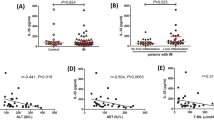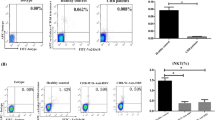Abstract
In hepatitis C virus (HCV) infection, TGF-β1 is upregulated in the liver and may be involved in the pathogenesis of chronic liver disease. TGF-β1 is also produced by activated T cells and acts as a potent immunosuppressor. The aim of this study was to investigate the roles of TGF-β1 in HCV-specific cytotoxic T lymphocyte (CTL) induction and enhance their killer activity by TGF-β1 modulation. We generated anti-HCV CTL from peripheral blood mononuclear cells from HLA-A2 patients under stimulation with the HCV-core peptide having the HLA-A2.1 binding motif. The lytic activities of CTL or precursor frequency (CTLpf) generated with or without anti-TGF-p antibody were compared. To optimize the IL-2 dose for CTL induction, low (50 U/ml) and high (500 U/ml) doses were tested and the lytic activities were compared. TGF-β1 amounts in the supernatants were assessed by enzyme-linked immunosorbent assay and by their growth inhibitory effect on mink lung epithelial cells. CTL activity was enhanced by anti-TGF-β antibody in a dose-dependent manner but CTLpf did not significantly change. A high dose of IL-2 reduced the activity to 45% of that observed with a low dose, whereas TGF-β1 increased as the dose of IL-2 increased. Exogenous IL-10 reversed the inhibitory effect of a high dose of IL-2 on the killing activity by reducing TGF-β1 mRNA expression in T cells and its production. These results demonstrated that endogenous TGF-β1 is an autocrine suppressor in CTL induction in vitro. Therefore, the blockade of endogenous TGF-β1 could enhance the killing potential of anti-HCV CTL.
Similar content being viewed by others
REFERENCES
Kagi D, Ledermann B, Burki K, Zinkernagel RM, Hengartner H: Molecular mechanisms of lymphocyte-mediated cytotoxicity and their role in immunological protection and pathogenesis in vivo. Annu Rev Immunol 14:207-232, 1996
Shirai M, Okada H, Nishioka M, Akatsuka T, Wychowski C, Houghton R, Pendleton CD, Feinstone S, Berzofsky JA: An epitope in hepatitis C virus core region recognized by cytotoxic T cells in mice and humans. J Virol 68:3334-3342, 1994
Battegay M, Fikes J, DiBisceglie AM, Wentworth PA, Sette A, Celis E, Ching WM, Grakoui A, Rice CM, Kurokohchi K, Berzofsky JA, Hoofnagel JH, Feinstone SM, Akatsuka T: Patients with chronic hepatitis C have circulating cytotoxic T cells which recognize hepatitis C virus-encoded peptides binding to HLA-A2.1 molecules. J Virol 69:2462-2470, 1995
Koziel MJ, Dudley D, Afdhal N, Choo QL, Houghton M, Ralston R, Walker BD: Hepatitis C virus (HCV)-specific cytotoxic T lymphocytes recognize epitopes in core and envelope proteins of HCV. J Virol 67:7522-7532, 1993
Massague J: The transforming growth factor-β family. Annu Rev Cell Biol 6:597-641, 1990
Sporn MB, Roberts AB: Transforming growth factor-β: Recent progress and new challenges. J Cell Biol 119:1017-1021, 1992
Castilla A, Prieto J, Fausto N: Transforming growth factor β1 and α in chronic liver disease. Effects of interferon alfa therapy. N Engl J Med 324:933-940, 1991
Ruscetti F, Varesio L, Ochoa A, Ortaldo J: Pleiotropic effects of transforming growth factor-β on cells of the immune system. Ann NY Acad Sci 685:488-500, 1993
Lucas C, Bald LN, Fendly BM, Mora-Worms M, Figari IS, Patzer EJ, Palladino MA: The autocrine production of transforming growth factor-β1 during lymphocyte activation. A study with a monoclonal antibody-based ELISA. J Immunol 145:1415-1422, 1990
Ota M, Seki T, Fukushima H, Tsuji K, Inoko H: HLA-DRB1 genotyping by modified PCR-RFLP method combined with group-specific primers. Tissue Antigens 39:187-202, 1992
Okamoto H, Sugiyama Y, Okada S, Kurai K, Akahane Y, Sugai Y, Tanaka T, Sato K, Tsuda F, Miyakawa Y and Mayumi M: Typing hepatitis C virus by polymerase chain reaction with type-specific primers: Applications to clinical surveys and tracing infectious sources. J Gen Virol 73:673-679, 1992
Simmonds P, Alberti A, Alter HJ, Bonino F, Bradley DW, Brechot C, Brouwer JT, Chan SW, Chayama K, Chen DS, Choo QL, Colombo M, Cuypers HM, Date T, Dusheiko GM, Esteban JI, Fay O, Hadziyannis SJ, Han J, Hatzakis A, Holmes EC, Hotta H, Houghton M, Irvine B, Kohara M, Korberg JA, Kuo G, Lau J, Lelie PN, Maertens G, McOmish F, Miyamura T, Mizokami M, Nomoto A, Prince AM, Reesink HW, Rice C, Roggendorf M, Schalm SW, Shikata T, Shimotohno K, Stuyver L, Trepo C, Weiner A, Yap PL, Urdea MS: A proposed system for the nomenclature of hepatitis C virus genotypes. Hepatology 19:1321-1324, 1994
Sharrock CEM, Kaminski E, Man S: Limiting dilution analysis of human T cells: A useful clinical tool. Immunol Today 11:281-286, 1990
Borysiewicz LK, Graham S, Hickling JK, Mason PD, Patrick Sissons JG: Human cytomegalovirus-specific cytotoxic T cells: Their precursor frequency and stage specificity. Eur J Immunol 18:269-275, 1988
Tada T, Ohzeki S, Utsumi K, Takiuchi H, Muramatsu M, Li XF, Fujiwara H, Hamaoka T: Transforming growth factor-β-induced inhibition of T cell function. Susceptibility difference in T cells of various phenotypes and functions and its relevance to immunosuppression in the tumor-bearing state. J Immunol 146:1077-1082, 1991
Fox FE, Ford HC, Douglas R, Cherian S, Nowell PC: Evidence that TGF-β can inhibit human T-lymphocyte proliferation through paracrine and autocrine mechanisms. Cell Immunol 150:45-58, 1993
Geller RL, Smyth MJ, Strobl SL, Bach FH, Ruscetti FW, Longo DL, Ochoa AC: Generation of lymphokine-activated killer activity in T cells. Possible regulatory circuits. J Immunol 146:3280-3288, 1991
Yamamoto H, Hirayama M, Genyea C, Kaplan J. TGF-β mediates natural suppressor activity of IL-2-activated lymphocytes. J Immunol 152:3842-3847, 1994
de Waal Malefyt R, Yssel H, Roncarolo MG, Spits H, de Vries JE: Interleukin-10. Curr Opin Immunol 4:314-320, 1992
Van-Vlasselaer P, Falla V, Van-Den-Heuvel R, Dasch J, de-Waal-Malefijt R: Interleukin-10 stimulates hematopoiesis in murine osteogenic stroma. Clin Orthop 313:103-114, 1995
Van-Vlasselaer P, Borremans B, van-Gorp U, Dasch JR, de-Waal-Malefijt R: Interleukin-10 inhibits transforming growth factor-beta synthesis required for osteogenic commitment of mouse bone marrow cells. J Cell Biol 124:569-577, 1994
Su HC, Kimberly A, Leite-Morris, Braun L, Biron CA: A role for transforming growth factor-β1 in regulating natural killer cell and T lymphocyte proliferative responses during acute infection with lymphocytic choriomeningitis virus. J Immunol 147:2717-2727, 1991
Bellone G, Aste-Amezaga M, Trinchieri G, Rodeck U: Regulation of NK cell functions by TGF-β1. J Immunol 155:1066-1073, 1995
Smyth MJ, Strobl SL, Young HA, Ortaldo JR, Ochoa AC: Regulation of lymphokine-activated killer activity and poreforming protein gene expression in human peripheral blood CD8+ T lymphocytes. Inhibition by transforming growth factor-β. J Immunol 146:3289-3297, 1991
Brown PD, Wakefield AD, Levinson AD, Sporn MB: Physicochemical activation of recombinant latent growth factor-beta's 1,2,3. Growth Factors 3:35, 1990
Lyons RM, Keski-Oja J, Mosea HL: Proteolytic activation of latent transforming growth factor-β from fibroblast-conditioned medium. J Cell Biol 106:1659, 1988
Yoo YD, Ueda H, Park K, Flanders KC, Lee YIK, Jay G, Kim SJ: Regulation of transforming growth factor-β1 expression by the hepatitis B virus (HBV) × transactivator. Role in HBV pathogenesis. J Clin Invest 97:388-395, 1996
Minutello MA, Pileri P, Unutmaz D, Censini S, Kuo G, Houghton M, Brunetto MR, Bonino F, Abrignani S: Compartmentalization of T lymphocytes to the site of disease: Intrahepatic CD4+ T cells specific for the protein NS4 of hepatitis C virus in patients with chronic hepatitis C. J Exp Med 178:17-25, 1993
Inge TH, Hoover SK, Susskind BM, Barrett SK, Bear HD: Inhibition of tumor-specific cytotoxic T-lymphocyte responses by transforming growth factor β1. Cancer Res 52:1386-1392, 1992
Gorelik L, Bar-Dagan Y, Mokyr MB: Insight into the mechanism(s) through which TNF promotes the generation of T cell-mediated antitumor cytotoxicity by tumor bearer splenic cells. J Immunol 156:4298-4308, 1996
Author information
Authors and Affiliations
Rights and permissions
About this article
Cite this article
Kanto, T., Takehara, T., Katayama, K. et al. Neutralization of Transforming Growth Factor β1 Augments Hepatitis C Virus-Specific Cytotoxic T Lymphocyte Induction in Vitro . J Clin Immunol 17, 462–471 (1997). https://doi.org/10.1023/A:1027367626317
Issue Date:
DOI: https://doi.org/10.1023/A:1027367626317




